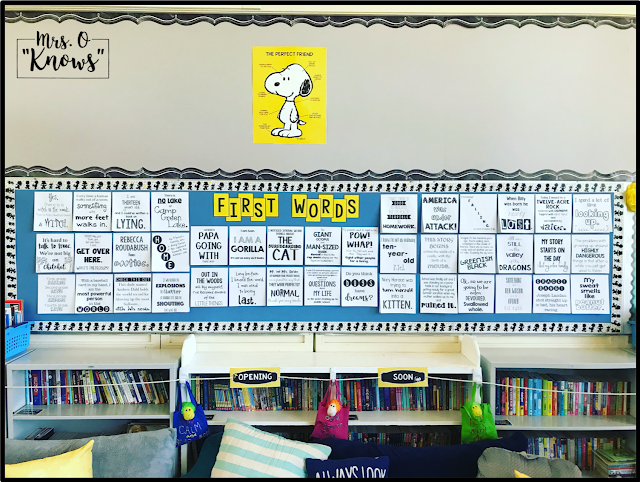I love reading! Each year, it is my goal to pass my love of reading on to my students. I stock my classroom library with tons of books and have reached a collection of over 1,000. I am extremely proud of my library and love to see my students checkout books and discover the journey of reading!
However, after years of teaching, I noticed that some really good books never leave the shelf. I realize there are classics that I love that may no longer interest students, but those are a small portion of the books I'm referring to. I have hundreds of books that students aren't even considering, books that I know at least one student would fall in love with if they'd be willing to give it a try.
I've been thinking a lot about ways to convince my students to at least give these books a try. At the end of last year, I sat down and evaluated the books that had been checked out the most. I use Booksource Classroom Organizer, so I was able to print out reports which allowed me to see the books that were checked out during the course of the year. As expected, there were some series that really stood out (I'm looking at you, Diary of a Wimpy Kid), but something else caught my attention - the books I'd labeled easy and challenging weren't being touched. Students who were capable of reading more challenging text weren't. Those "striving readers" (thank you for this perfect term, Stephanie Harvey) were choosing grade level books that were too hard for them and leaving my easy section untouched. The majority of the books that were checked out were labeled on grade level. That's when I realized that my leveling was actually getting in the way of students enjoying a wonderful book.
GOODBYE, LEVELED LIBRARY!
That realization told me it was time to make a BIG change. I let go of levels. No AR, no Lexile, no F&P, no nothing. It's something I'd been thinking about a lot, especially after reading The Book Whisperer and a number of other professional books and blogs which discouraged the idea. (On a side note, F&P was apparently never meant to become a leveling system for classroom libraries. Click here to read more about this.)
This summer, I had some student helpers come in for a few days. We spent the first day taking all of the stickers off of every single one of my books. We made a gigantic pile of books on the floor. I'll admit, about half way through the unleveling process, I had a bit of a panic, but I held strong to my gut feeling that this was the change I needed. The next two days were spent sorting my books by genre, and I definitely couldn't have done this without helpers. By the time we finished, we had sorted all of the books into specific genres without consideration of level. I used mini dot stickers to organize the genres (one green for realistic fiction, one red for mystery, etc.) and put the books back on the shelf in a way that I'd never done in 13 years. I was excited to try something new and see if this change would make a difference.
Here's an additional link if you are thinking about saying goodbye to levels: Leveled Libraries are Outdated
FIRST WORDS BULLETIN BOARD
Of course, the true test would be to see what happened when the students arrived and began to checkout books. I wanted to grab their attention from the moment they walked in on the first day of school, so I did a repeat of a bulletin board from the year before, one titled "First Words", an idea I got from Literacy for Big Kids. On this board, I used 40 different first lines from 40 different books in my library, many of which were those amazing books that were going untouched. Under each quote, I placed a picture of the cover and it's location in our library, by genre, of course! It's a huge board and students were chatting about it from the minute they walked in the door. Once I told them that they could actually come up and lift the quote to see what book it was from, they were eager to begin to checkout books from our library.
 |
| A quick tour of my board. |
BOOK PREVIEWS HAVE BEEN A GAME CHANGER
I made one more change that has been a total game changer. I decided to add a daily book recommendation on my morning slide and to "preview" a new book each day for the first 40 days. In another attempt to increase student interest in books that may otherwise be ignored, I read a chapter or two from the daily recommended book. In the three weeks that I have been doing this, the response has been AMAZING! I wish I had done book previews years ago. Students are actually begging to checkout books and sometimes we have to draw sticks for a fair decision on who can check it out first. If students already have a great book, they are adding it to their "to-read" list in their 40 Book Challenge binders. And of course, I'm not even mentioning levels during these previews. Book previews are going so well that I may continue it well beyond the first 40 days!
SO FAR, SO GOOD!
Now, all of this doesn't mean that I've stopped thinking about levels entirely. I'm a teacher, it's my job to consider level when planning instruction. I've just taken a new approach to my classroom library. I spend a considerable amount of time discussing and modeling the right time to abandon a book and students are getting really good at recognizing when a book isn't right for them. Students are now exploring books that went untouched for years. They are no longer disqualifying a book because it's not on their level. Instead, they are thinking about the genres they enjoy, the book previews that interest them, the reviews of their peers, my additional recommendations, and their own enjoyment of the book once they check it out and begin their journey.
A colleague stopped in when I was doing a book preview during the first week of school. Afterwards, I mentioned the changes I'd made. She said, "If it works for one, it was worth it." Of course, I said, "No, it has to work for all!" That may be incredibly optimistic of me, but the following conversations have taken place since I made these changes:
One morning during our second week of school:
Future Bookworm: "Mrs. Ostrander, I spent three hours reading that book last night. It was so emotional and amazing. Did you know it's a series? Do you have any more?"
(I didn't, but I surely went on Amazon to order the rest, and she is already on the last book of the three-book series. We started school on August 14th.)
At back to school night:
Parent: "My daughter has read more books in one week than she read all summer."
After a preview of Refugee:
Future Bookworm 1: "I don't think I can do historical fiction, it's just too real."
Future Bookworm 2: "Well, good, because I want that book first!"
Future Bookworm 3: "Are you kidding? I was hoping I'd get it. There's so much action, I just can't wait to read more!"
One very quiet student who has fallen in love with a graphic novel series:
Me: "I've noticed that you really love that series. Did you know that there are more? Would you be interested in reading them?"
Future Bookworm: "Mrs. Ostrander, I'd read every single one if we had it."
(She's now read 5 in the series. I've just placed a second order for the rest.)
They're falling in love with reading, one book at a time. I'm sticking to my optimistic hope that I'll have 25 bookworms by June!
















































